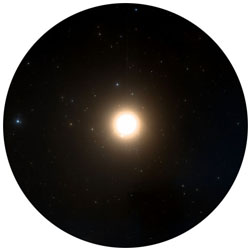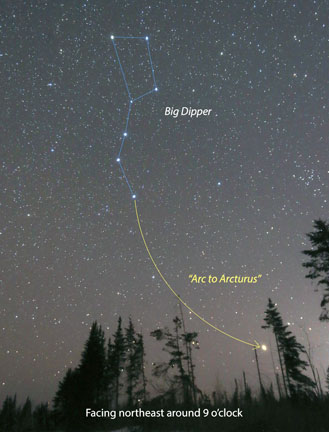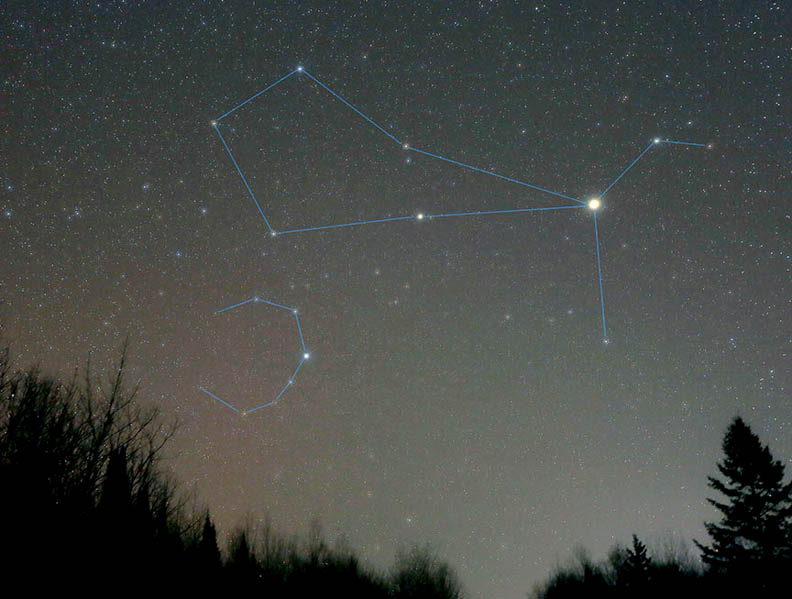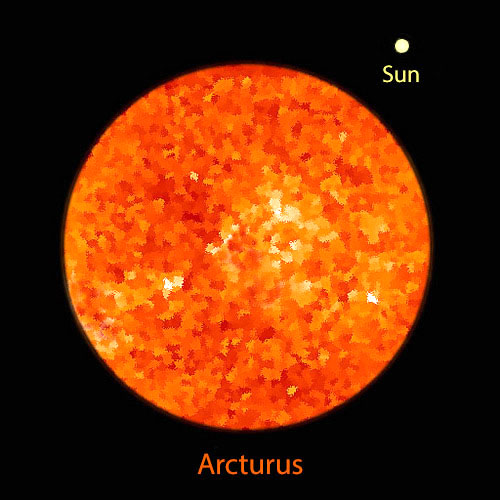Stars are time machines that can transport us into the past or future. They can also illuminate our own personal journeys, as Arcturus did for me one night.

DSS2
Last fall, we had to put our 18-year-old dog Sammy down. It was a sad occasion. For years, we'd walk at night under stars, clouds, snow, and rain. Now, I walk alone but keep her memory. These past few weeks, the sky has shifted from winter to spring both in temperature and content. Orion is ambling westward, and a new star gleams in the east off the handle of the Big Dipper: Arcturus.
I love this star. It really lights up the eastern sky not just with brilliance (it's the 4th brightest in the night sky) but color. Arcturus is an orange giant with a warm hue like one of those floating sky lanterns.
Astronomers have precisely measured its distance from Earth at 36.7 light-years or 220 trillion miles, making Arcturus one of the closest bright stars. It's large, too — 25 times the size of the Sun and 110 times brighter in visible light. Put in place of our star it would fill a quarter of Mercury's orbit.

Bob King
While Arcturus glimmers brightly at magnitude 0, if you took the Sun and moved it 36.7 light-years from home, it would shine about 100 times fainter (magnitude 5). You'd need a dark sky and moonless night to find it. But here's the crazy thing, Arcturus is only 1.08 times as massive as the Sun. They have nearly the same amount of stuff, so how come Arcturus is brilliant and the Sun barely registers?
Arcturus is about 7 billion years old, some 2 billion years older than the sun. As a Sun-like star ages, it uses up the hydrogen in its heart and switches over to burning it in a shell outside the core. It also begins cooking helium, a byproduct of hydrogen burning that accumulates in the core. How convenient to incinerate one fuel to make another!
The transition in how and what the star burns causes it to expand to many times its original size. Even though Arcturus has a lower surface temperature than the Sun due to that expansion (the reason it appears orange), its vastly greater surface area makes it many times brighter.
In a couple billion years, the Sun will likewise balloon out and brighten. When that day comes, Arcturus, born before the Sun and forever a step ahead, will have blown its outer envelope into space, leaving behind a tiny, invisible-to-the-naked-eye white dwarf.

Bob King
As my dog aged, she lost full use of her back legs and had other issues as well. A year ago under another spring sky, I knew where this was all headed and dreaded the decision that would have to be made.

Wikipedia / Bob King
I still enjoy my nightly strolls and watching the stars change with the seasons. Some constellations bring the tingle of winter, others shout spring. Arcturus reminds me that the future transforms everything, and that a star is so much easier to let go of than a dog.
 13
13








Comments
misha17
March 21, 2018 at 7:51 pm
My wife did her best to share my love of astronomy even if it meant getting up in the middle of the night to watch lunar eclipses. Orion was about the only constellation that she knew before I met her. I taught her the saying, "Start with the handle of the Big Dipper, (make an) arc to Arcturus, then a spike to Spica". We carpooled to and from work, and every night when we would get home on Spring and Summer evenings, the first the we'd do as we got out of the car is look up at the sky, look for the Dipper and those stars, reciting the saying as we did that, then give a quick kiss and hug before we went inside.
Sadly, she passed away in the Spring over 10 years ago, but I still make it a habit to go out and look for "our stars", say that saying, and give a quick "I love you", before I go inside.
You must be logged in to post a comment.
Bob KingPost Author
March 21, 2018 at 8:07 pm
Misha,
Thank you for sharing that touching story. Stars can have much meaning beyond their physical qualities (as interesting as those are).
You must be logged in to post a comment.
Anthony Barreiro
March 22, 2018 at 1:38 pm
Bob, I am very sorry for the loss of Sammy. She sounds like a wonderful companion. I imagine that while you were enjoying the sky, she was enjoying all the intricate nighttime smells!
There is some solace in understanding the great sweep of space and time that is our cosmos.
"Though my soul may set in darkness, it will rise in perfect light;
I have loved the stars too fondly to be fearful of the night."
-- Sarah Williams, from "The Old Astronomer to His Pupil"
You must be logged in to post a comment.
Tom-Reiland
March 22, 2018 at 5:17 pm
Anthony, The last line of the Sarah Williams poem is on John Brashear's Crypt in Allegheny Observatory. Those of us in the Amateur Astronomers Association of Pittsburgh and who worked at Allegheny Obs know that line and the poem well. It is mentioned in his biographies and his autobiography. What a fantastic way to consider the night sky.
You must be logged in to post a comment.
Anthony Barreiro
March 22, 2018 at 5:32 pm
Tom, I think we need both lines of the final couplet to capture the sense of Williams' poem. While we may not be religious, the poem expresses faith in an eternal soul that survives death.
You must be logged in to post a comment.
Tom-Reiland
March 23, 2018 at 5:01 pm
Anthony, though I understand your feelings about the poem, I personally prefer just the last line. It's all I need to illustrate my love of the night sky. By the way, John Brashear changed the "I" to "We" on the marker in the crypt that holds both he and his wife, Phoebe, who preceded him in death. I feel honored to have worked in the observatory that he directed and also managed its construction and to observe on the 30 Inch Thaw Refractor and 31 Inch Keeler Reflector.
You must be logged in to post a comment.
Bob KingPost Author
March 22, 2018 at 8:39 pm
Anthony,
Thank you for that. And yes, I think she was as entranced by smells as I was by sights.
You must be logged in to post a comment.
Tom-Reiland
March 22, 2018 at 5:11 pm
Bob, having had to euthanize several cats over the years, I fully understand what you are going through. They have their own special place in our hearts. 25 years, when I had three cats, they would come out in my backyard with me where I set up my 16" Dob for some late night observing. They would climb in and out of the dob mount and chase each other while I was trying to observe. I really miss those nights. Your experience with Arcturus reminds me of Leslie Peltier's first observation with his "Strawberry Spyglass." Vega was the first celestial object that he viewed through that 2" refractor. My first scope, and my brother's, was a 2.4" Gilbert Reflector that I refurbished when my interest in astronomy was rekindled and my brother still has it. I found another one on the doorstop at Wagman Observatory and rebuilt it, also. I remember observing Mizar and Alcor, the Moon, Jupiter with the Red Spot and its moons and the Orion Nebula through it in the 1950s. I enjoy watching the stars as they move through the sky from one season to the next. Arcturus, Capella, Vega and the Winter stars are my favorite ones to follow. Thanks again, for bringing back these memories.
You must be logged in to post a comment.
Bob KingPost Author
March 22, 2018 at 8:45 pm
Thanks for writing, Tom. Your story about the cats reminded me that when I'd observe from home, Sammy used to lie nearby gnawing on her bone with the same intensity I hunted comets and deep sky with the scope. BTW, we both had the same first telescope, the 2.4" Gilbert 🙂
You must be logged in to post a comment.
bwana
March 23, 2018 at 7:05 pm
I've had to say a sad good bye to far more dogs than I can remember...
However, looking up at the night sky with its planetary nebulas, supernova remnants, neutron stars and black holes I realize that all things ultimately die AND at some point even our Universe will meet its end.
From stardust I was born, to stardust I shall return...
bwa
You must be logged in to post a comment.
jblakeslee
March 24, 2018 at 2:48 am
Dear Bob,
I enjoyed your article. One minor comment: Arcturus is a red giant, and stars on the red giant branch have exhausted their core hydrogen, but have not yet built up a sufficient mass of helium to undergo helium fusion. Instead, they continue to burn hydrogen in a spherical shell around the inert core. At some point, the central density becomes high enough to undergo helium burning, and then star evolves from the RGB to the horizontal branch. Core-helium burning stars are hotter (bluer) and have smaller radii.
Best wishes.
You must be logged in to post a comment.
Bob KingPost Author
March 24, 2018 at 9:59 am
Hi jblake,
Thank you for your comment about Arcturus. I'll often check stellar particulars with Prof. James Kaler and he notes that Arcturus has likely already begun fusing helium. But there's no doubt as you wrote that the hydrogen-burning shell has contributed to its expansion and great size. To that end I've updated the article to reflect that fact, too. Thank you.
You must be logged in to post a comment.
AB
April 6, 2018 at 12:42 am
Dear Bob,
My sympathy for the loss of your Sammy. I know that heartache. There is a star in Leo, the great cat, named now for my cat-child whom I lost recently too. Of course not official, chosen for free on Staracle, but a gesture that was meaningful to me. The first time I saw it through my telescope, I felt her with me. We are all made of the same stardust.
You must be logged in to post a comment.
You must be logged in to post a comment.